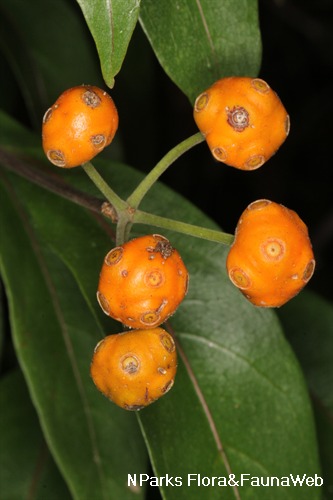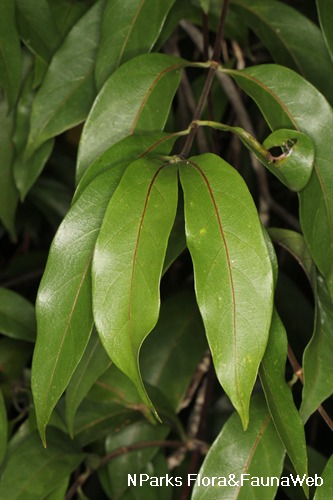
Back
Gynochthodes umbellata (L.) Razafim. & B.Bremer
| Family Name: | Rubiaceae |
| Synonyms: | Morinda umbellata L. |
| Common Name: | Akar Ketang, Akar Perut Ayam, Buah Butang, Mengkudu Akar, Mengnkudu Hutan, Mengkudu Jantan, Mengkukdu Kechil, 印度羊角藤 |
Name
Classifications and Characteristics
| Plant Division | Angiosperms (Flowering Seed Plants) (Dicotyledon) |
|---|---|
| Plant Growth Form | Climber |
| Lifespan (in Singapore) | Perennial |
| Mode of Nutrition | Autotrophic |
Biogeography
| Native Distribution | Northeast India, Japan, China, Peninsular Malaysia, Singapore, tropical Australia and West Pacific. |
|---|---|
| Native Habitat | Terrestrial (Primary Rainforest, Secondary Rainforest, Coastal Forest) |
| Preferred Climate Zone | Tropical, Sub-Tropical / Monsoonal |
| Local Conservation Status | Native to Singapore (Least Concern (LC)) |
Description and Ethnobotany
| Growth Form | It is a thin, semi-woody to woody climber. |
|---|---|
| Foliage | Its opposite, stalked leaves have thin, leathery blades that are usually narrowly oblong or oval to lance-shaped, dark green above, green below, 8.9–13 by 2.5–3.4 cm, and have 5–6 pairs of veins. |
| Flowers | Its flowers have white, bell-shaped petals that are covered with woolly hair on the inside and tips, and the flowers are arranged in clusters at the end of flowering branches. |
| Fruit | Its fruits are arranged in round to oblong, red, 1 cm wide infructescences. |
| Habitat | It grows in inland forests and coastal habitats. It occurs locally in Pulau Ubin (including Chek Jawa), Pulau Tekong (including Pulau Tekong Kechil), Central Catchment Nature Reserve (including Upper Peirce Reservoir), Bukit Timah Nature Reserve, Labrador Park, and Sentosa Island. |
| Associated Fauna | Its flowers are insect-pollinated. |
| Cultivation | It can be propagated by seed. |
| Etymology | Latin umbellata, with the branches of the flower clusters all rising from the same point |
| Ethnobotanical Uses | Edible Plant Parts : Edible Fruits Food (Fruit or Vegetable): The ripe fruits are eaten raw. (Herb or Spice): The unripe, green fruits are used in curries. Medicinal: The boiled roots are applied to treat dropsy and a decoction of the leaves and roots are used to expel parasitic worms in the body. Others: Its roots are used to make yellow dye. The tough stems can be used as rough ropes. |
Landscaping Features
| Landscaping | It is suitable for growing on trellises and pergolas. |
|---|---|
| Desirable Plant Features | Ornamental Fruits |
| Landscape Uses | Parks & Gardens, Small Gardens, Coastal, Trellis / Arbour / Pergola |
Fauna, Pollination and Dispersal
| Pollination Method(s) | Biotic (Fauna) |
|---|---|
| Seed or Spore Dispersal | Biotic (Fauna) |
Plant Care and Propagation
| Light Preference | Full Sun |
|---|---|
| Water Preference | Little Water, Moderate Water |
| Plant Growth Rate | Moderate |
| Rootzone Tolerance | Moist Soils, Well-Drained Soils, Saline Soils / Salt Spray, Fertile Loamy Soils |
| Propagation Method | Seed |
Foliar
| Foliage Retention | Evergreen |
|---|---|
| Mature Foliage Colour(s) | Green |
| Mature Foliage Texture(s) | Leathery, Thin |
| Foliar Type | Simple / Unifoliate |
| Foliar Arrangement Along Stem | Opposite |
| Foliar Attachment to Stem | Petiolate |
| Foliar Shape(s) | Non-Palm Foliage |
| Foliar Venation | Pinnate / Net |
| Foliar Margin | Entire |
Floral (Angiosperm)
| Flower & Plant Sexuality | Bisexual Flowers |
| Flower Colour(s) | White |
|---|---|
| Flower Texture(s) | Hairy / Hirsute |
| Flower Grouping | Cluster / Inflorescence |
| Flower Symmetry | Radial |
Fruit, Seed and Spore
| Mature Fruit Colour(s) | Orange, Red |
|---|---|
| Fruit Classification | Simple Fruit |
| Fruit Type | Fleshy Fruit , Non-Accessory Fruit |
References
| References | Razafimandimbison, S.G. & Bremer, B.. 2011. Nomenclatural changes and taxonomic notes in the tribe Morindeae (Rubiaceae). Adansonia Ser 3. . 33 (2): 283 - 309 |
|---|
Image Repository
Others
| Master ID | 160 |
|---|---|
| Species ID | 1456 |
| Flora Disclaimer | The information in this website has been compiled from reliable sources, such as reference works on medicinal plants. It is not a substitute for medical advice or treatment and NParks does not purport to provide any medical advice. Readers should always consult his/her physician before using or consuming a plant for medicinal purposes. |





